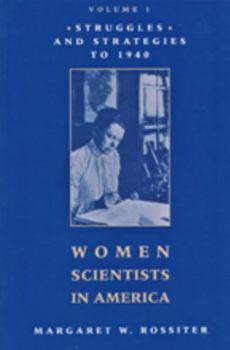Women Scientists in America: Struggles and Strategies to 1940
Select Format
Select Condition 
Book Overview
Winner of the Berkshire Conference of Women Historians Prize In volume one of this landmark study, focusing on developments up to 1940, Margaret Rossiter describes the activities and personalities of the numerous women scientists--astronomers, chemists, biologists, and psychologists--who overcame extraordinary obstacles to contribute to the growth of American science. This remarkable history recounts women's efforts to establish themselves...
Format:Paperback
Language:English
ISBN:0801825091
ISBN13:9780801825095
Release Date:January 1982
Publisher:Johns Hopkins University Press
Length:464 Pages
Weight:1.19 lbs.
Dimensions:1.2" x 5.9" x 9.1"
Customer Reviews
1 rating
Finally, some explanations!
Published by Thriftbooks.com User , 23 years ago
Margaret Rossiter's work clearly outlines the rise in 19th century America of the notion that girls and women ought to be educated, and deftly constructs a gripping read about how this relatively new notion translated itself into women finally attaining access to higher education. She goes in-depth in examining each successive generation, from the 1840s onwards, in showing how, once one generation of women attained a certain level of education in the sciences, they sought to give the same and more opportunities to the next set of young women. Rossiter also clearly delineates part of what is probably at the origin of women's pay imbalance today: once so many women attained higher degrees, there was nowhere else for them to go, including the women's colleges where jobs were scarce. They therefore accepted much lower-paying jobs as "scientists' assistants" in the astronomy, botany, or other laboratory simply to utilize the knowledge they had gained. Rossiter's work gives insights into the hard-won educational rights we now take for granted, but illuminates some situations that have persisted into the present day. My only criticism of the work is that she mentions so many names of women becoming scientists, particularly in the 1880s and 1890s, that it became a bit confusing to keep them all straight. While she has charts showing how many women were attaining degrees at various women's, and finally coed, institutions, it would have been helpful to have a "genealogy" of all of these scientists. All in all one of the most interesting books I have read in months.





